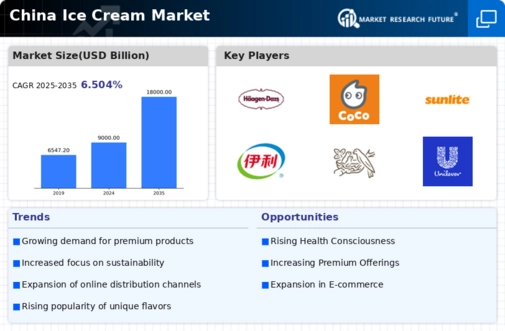Rising Disposable Income
The increasing disposable income among consumers in China appears to be a significant driver for the ice cream market. As individuals have more financial resources, they are likely to indulge in premium and artisanal ice cream products. Reports indicate that the average disposable income in urban areas has risen by approximately 8% annually, leading to a greater willingness to spend on luxury food items. This trend suggests that the ice cream market could experience substantial growth as consumers seek higher-quality options. Furthermore, the expansion of middle-class households is likely to contribute to a shift in consumption patterns, favoring indulgent treats. The ice cream market may benefit from this economic uplift, as consumers increasingly prioritize quality and unique flavors over basic offerings.
Innovative Flavor Profiles
Innovation in flavor profiles is emerging as a key driver in the ice cream market. Chinese consumers are becoming more adventurous, seeking unique and exotic flavors that reflect local tastes and preferences. The introduction of flavors such as matcha, red bean, and lychee has gained popularity, indicating a shift towards more culturally relevant offerings. Market data suggests that products featuring innovative flavors have seen a sales increase of around 15% in recent years. This trend not only caters to the evolving palate of consumers but also enhances brand differentiation in a competitive landscape. The ice cream market is likely to thrive as manufacturers continue to experiment with new ingredients and flavor combinations, appealing to a broader audience.
Growing Urbanization Trends
Urbanization in China is a critical driver for the ice cream market, as more individuals migrate to urban areas seeking better opportunities. This demographic shift is leading to an increase in the number of potential consumers who have access to a variety of ice cream products. Urban centers are witnessing a rise in modern retail formats, such as convenience stores and specialty ice cream shops, which cater to the growing demand. Data indicates that urban populations are expected to reach 70% by 2030, further expanding the customer base for the ice cream market. The ice cream market is likely to benefit from this trend, as urban consumers often seek convenient and indulgent food options.
Seasonal Demand Fluctuations
Seasonal demand fluctuations significantly impact the ice cream market in China. The peak consumption period typically occurs during the summer months, where sales can increase by as much as 30% compared to winter. This seasonal trend suggests that manufacturers and retailers must strategically plan their production and marketing efforts to capitalize on these high-demand periods. Additionally, festive seasons, such as the Lunar New Year, also drive unique consumption patterns, with consumers purchasing ice cream as gifts or for celebrations. The ice cream market must remain agile to adapt to these seasonal variations, ensuring that supply aligns with consumer demand throughout the year.
Healthier Alternatives and Ingredients
The demand for healthier alternatives in the ice cream market is becoming increasingly pronounced. As consumers in China become more health-conscious, there is a noticeable shift towards products that offer lower sugar content, natural ingredients, and functional benefits. Ice cream brands are responding by introducing options that incorporate superfoods, probiotics, and reduced-calorie formulations. Market analysis suggests that products marketed as healthier alternatives have experienced a growth rate of approximately 12% in recent years. This trend indicates that the ice cream market must adapt to changing consumer preferences, focusing on transparency in ingredient sourcing and promoting health-oriented messaging to attract a broader audience.


















Leave a Comment